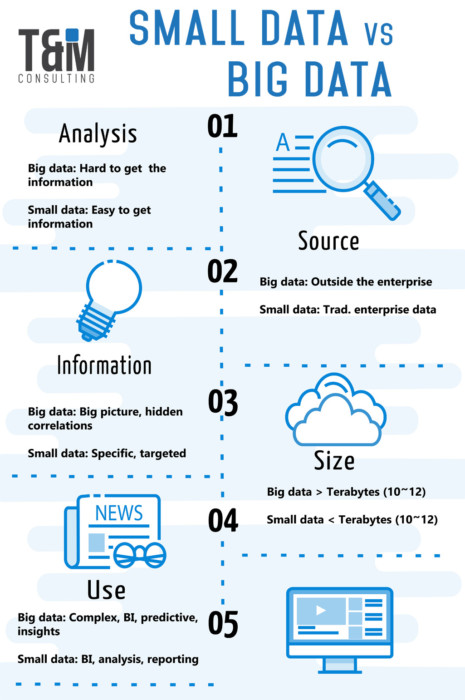 Small Data is the process by which we use and analyze data of smaller size and simplicity. Data that affect our business. They are part of the daily routine and allow us to know better what happens in our environment. Also identifying opportunities for the efficiency of the processes and the relationship with customers.
Small Data is the process by which we use and analyze data of smaller size and simplicity. Data that affect our business. They are part of the daily routine and allow us to know better what happens in our environment. Also identifying opportunities for the efficiency of the processes and the relationship with customers.
Differences between Big Data and Small Data
According to Martin Lindstrom, “Big Data is about finding correlations. While Small Data cares about the causes, the reasons behind things” The Small Data adds value since not everything can be measured with figures.
Big Data gives way to Small Data among those responsible for marketing. A survey by Campaigner and J2 Global showed as a result that 34% of those responsible for marketing consider more detailed information related to the segment of their target audience. Followed by 18% who consider more relevant detail information related to their sector.
The impact of Small Data for the business
The Small Data is the new revolution. This refers to all the possibilities offered by these concepts. From the explotation of large volumes of information to facilitate decision-making. In short, all the knowledge we need can be acquired on a reduced set of data in “our” market-environment. To expand this knowledge, what we must do is analyze independently the different aspects. Those on which we want to have that knowledge, and integrate them in a packaged manner. Such as different Small Data subprojects. This recalls the techniques for the development of efficient algorithms, such as “divide and conquer”, also applicable to many other facets of life.
On an industrial level, Steven LaFevers indicates in his article published in FoodManufacturing that the industrial computer applications record various data. Certainly related to measurements in production and logistics, can collect very relevant data. Creating a small data key that can be quickly converted into data that can be processed by a Business Intelligence system.

